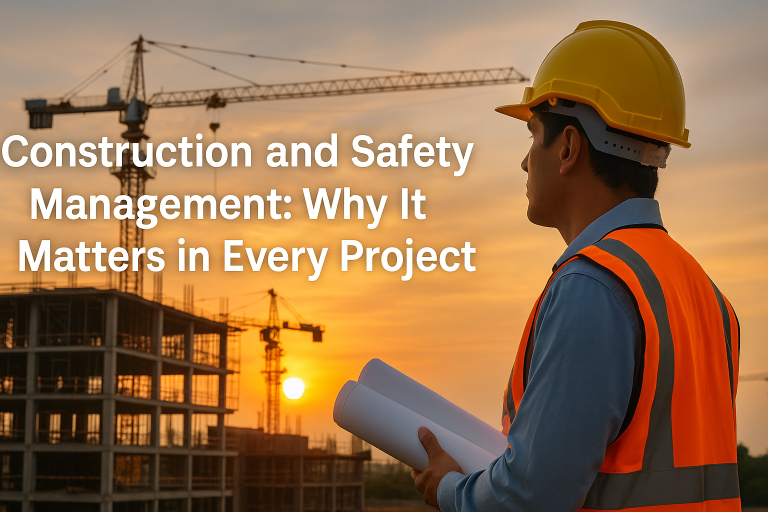Construction and Safety Management: Why It Matters in Every Project

-
 NEWGENE TECHNOLOGIES
NEWGENE TECHNOLOGIES
When you think of a construction site, you might picture heavy machinery, tall cranes, or workers in hard hats. But behind the scenes, there’s something even more important: safety. In any construction project, safety management plays a critical role in ensuring that both the workers and the project itself stay on track. Let’s dive into why safety and construction management should never be treated as an afterthought and how they affect the overall success of any construction project.
The Risks of Construction Work
Construction sites are among the most dangerous workplaces in the world. According to the U.S. Occupational Safety and Health Administration (OSHA), one in five worker fatalities in 2020 were in the construction industry. Common hazards include falls, machinery accidents, electrocution, and being struck by objects. These accidents not only harm workers but also disrupt the flow of the project, leading to delays and increased costs.
This is why construction safety isn’t just a luxury; it’s a necessity. Having a robust safety management plan can prevent these hazards and create a safer, more efficient working environment. In fact, studies show that companies with strong safety practices have up to 30% fewer accidents than those that don’t prioritize safety.
How Construction Management Integrates Safety
Construction management is the overall process of planning, coordinating, and overseeing a construction project from start to finish. A good construction manager ensures that the project stays on time, within budget, and meets quality standards. But when it comes to safety, construction management and safety management must go hand-in-hand.
For example, before beginning any phase of a project, construction managers should conduct thorough safety audits and identify potential risks. This includes evaluating the equipment, materials, and procedures that will be used at each stage of construction. Having a clear safety management plan in place from the beginning ensures that workers know what is expected of them and can follow the right protocols.
Real-World Example: A Bridge Construction Project
Let’s take a real-world example of a bridge construction project. In one case, a team working on a bridge construction project in New York was able to avoid serious accidents by implementing a proactive safety management system. Before the project began, managers conducted risk assessments and involved workers in discussing potential hazards. Regular safety drills were held, and any identified risks were addressed immediately.
This proactive approach allowed the team to avoid major injuries or fatalities, and the project was completed on time, within budget, and with minimal disruptions. The success of this project highlights the value of integrating safety into every phase of construction, from planning to execution.
The Benefits of Safety and Construction Management
Reduced Accidents and Injuries: Safety management is the most effective way to minimize workplace accidents. With proper training, hazard identification, and regular safety checks, the likelihood of injuries decreases significantly. In fact, studies have shown that projects with safety management programs experience 50-60% fewer injuries.
Better Project Efficiency: When safety protocols are clear, workers can focus on their tasks without worrying about their safety. This leads to higher productivity and fewer delays due to accidents or injuries.
Cost Savings: A strong safety program reduces the chances of costly delays, insurance claims, and legal disputes. In the long run, prioritizing safety can actually save money by preventing accidents that would otherwise disrupt the project.
Increased Worker Morale: Workers who feel safe are more likely to perform well. A safe environment boosts morale and helps retain skilled workers. Workers are also more likely to report hazards and follow protocols when they feel their safety is a priority.
Enhanced Reputation: Construction companies with a reputation for safety attract better clients and workers. A track record of completed projects without major incidents boosts credibility and trust within the industry.
The Role of Technology in Construction Safety Management
Advancements in technology are making it easier to enhance safety on construction sites. Tools like wearable safety devices, drones, and AI-based monitoring systems are transforming how construction safety is managed.
Wearable technology can monitor a worker’s health in real time, tracking vitals such as heart rate and temperature to detect signs of fatigue or distress. Drones equipped with cameras and sensors can conduct site inspections, identifying potential hazards from above. AI-based software can analyze data from previous projects to predict where accidents are most likely to happen, allowing managers to implement preventive measures before problems arise.
Protect your workforce and enhance project efficiency with NGT’s cutting-edge Safety Management Software. Our comprehensive solution simplifies safety compliance, reduces risks, and ensures smoother project execution. Ready to take your construction safety to the next level? Visit NGT Safety Management Software now and start streamlining your processes. Explore all our innovative solutions at NGT and build safer, more efficient projects today!
Conclusion
Construction and safety management are not separate entities; they are intertwined and must be handled with equal importance. Safety isn’t just about avoiding accidents—it’s about creating an environment where workers feel valued and the project runs smoothly. Whether it’s through proactive planning, regular training, or using the latest technology, ensuring safety on the job site is crucial for the success of any construction project. By prioritizing both safety and effective management, projects can be completed on time, within budget, and with the well-being of workers intact.